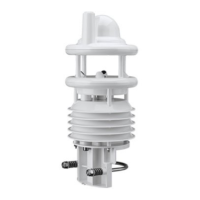
Do you have a question about the Lufft WS800-UBM and is the answer not in the manual?
| Protection Class | IP66 |
|---|---|
| Model | WS800-UBM |
| Manufacturer | Lufft |
| Measurement Range (RH) | 0 to 100% |
| Operating Temperature Range | -40 to 60 °C |
| Power Supply | 4 ... 30 VDC |
| Communication Interface | RS485 |
| Interfaces | RS485, SDI-12 |
| Measurement parameters | Temperature, Humidity, Precipitation, Pressure, Wind |
| Technology | Ultrasonic |
| Interface | RS485 |
| Function | Weather monitoring |
Explanation of warning and information symbols in the manual.
Critical safety precautions for installation and operation.
Specifies the intended purpose and operational limits of the equipment.
Potential consequences of improper installation or operation.
Details regarding the warranty period and conditions.
Acknowledgment of third-party brand names used.
List of optional accessories available for the weather sensors.
Information on available spare parts for the sensors.
Resources for further information and software downloads.
Air temp, humidity, pressure, precipitation, wind, compass, heating, global radiation, lightning, leaf wetness.
Details on external temperature and rain gauge sensors.
Illustrates the sensor technology with an example diagram.
How the last measurement value is transmitted.
Calculation and retrieval of minimum and maximum values.
Calculation and retrieval of average values.
Vectorial calculation for wind speed and direction.
Air temp, dew point, wind chill, wet bulb temp, specific enthalpy, air density.
Wind speed, direction, quality, and compass heading.
Absolute/differential quantity, intensity, and type.
Global radiation, heating temp, leaf wetness, lightning events, service messages.
Fastening the sensor and aligning it to North.
Key factors for choosing an optimal and safe installation site.
Guidelines for rain gauge, global radiation sensors, and general sketches.
Power requirements and RS485 communication details.
Connecting ISOCON-UMB, surge protection, leaf wetness, and external sensors.
Critical considerations for successful sensor setup and initial operation.
Default parameters and steps for configuring via software.
Performing tests and polling channels using the configuration tool.
Steps for cleaning and checking the rain gauge mechanism.
Current consumption, dimensions, weight, environmental and interface specs.
Detailed ranges and accuracies for all sensor measurements.
Precipitation, compass, global radiation, leaf wetness, and external sensor specs.
Dimensional drawings of the weather sensor units.
Contact information and resources for technical assistance.
Details on connecting the WLW100 leaf wetness sensor.
Procedure for adjusting the wetness threshold for accurate readings.
Connecting external temperature and rain gauge sensors.
Information on available NTC sensors for temperature acquisition.
Details on using external rain gauges with specific sensor models.
Overview of UMB channels and their data mapping.
Channel summaries specific to TLS2002 FG3 data requests.
Details on framing, addressing, and examples in binary communication.
Using ASCII for text-based commands and data requests.
Conformance and configuration for SDI-12 communication.
Integrating sensors with PLC environments via Modbus.
Transmitting data in NMEA compatible XDR format.